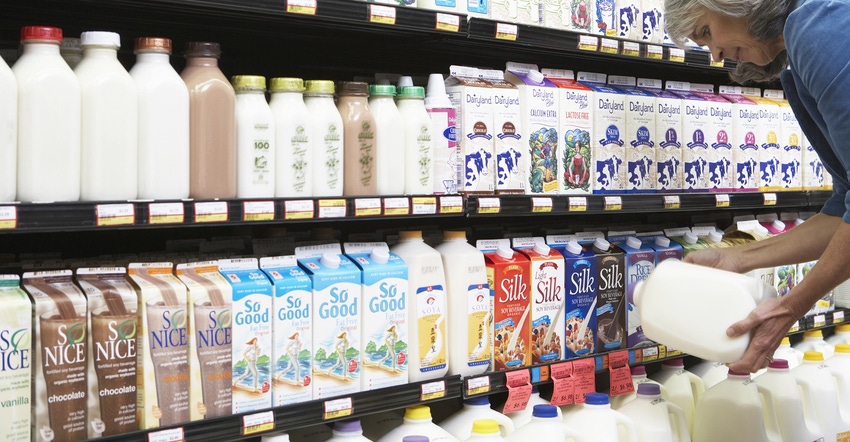
Standing in front of the grocer’s dairy section, milk choices have traditionally been whole milk, reduced-fat (2%), low-fat (1%), fat-free milk and chocolate.
How can something so uncomplicated become complicated? I cite the millennials for their incessant need for more choices.
Change and choices have their place, but milk seems to have been robbed of its title. There is now a vast array of “milks” out there, and the choices are growing.
Most everyone has heard of almond, rice, coconut and soy milk, which are the most popular dairy-free milks on the market. But now there are so many more. Some I never heard of until recently when several reports outlined predictions for top food items and trends for 2018.
To some degree, it wasn’t really surprising. The reports all predict there will be an ever-increasing focus on locally grown foods and beverages, as well as an increasing interest in healthy eating and the need for food transparency throughout the food system. People want to know where and who grew their food and how it was brought to the table.
There is also an increasing demand for “ethnic foods” or foods new to the general American palate.
The millennials have spoken with their wallets, and they’re saying, “We’re not afraid to try new things.”
I’m not sure that means chocolate-covered ants are going to become a sensation, but millennials, and the population in general, are making more food decisions based well beyond taste. Emphasis is shifting to how best to fuel the body with energy, while providing nutrition to keep it running well into the future.
Pea milk?
Getting back to milk, I discovered there are also oat, flax seed, quinoa and hemp milks (made from the seed). There are also more nut-based drinks coming from macadamia, hazelnut and cashews.
One article identifying healthy foods going mainstream cited pea milk and golden milk as the new “up-and-comers.”
Pea milk is the latest dairy alternative popular with vegans. It’s a nut-free option for lactose-intolerant consumers or those with a nut allergy. Its claim to fame is that it’s better for the environment than almond milk, which requires a tremendous amount of water for production. And it has more protein and calcium than other alternative milks.
One brand I’ve seen in Walmart is Bolthouse Farms Non-Dairy Plant Milk Protein. It’s made from peas, and boasts no preservatives or artificial flavors with 90 calories per cup and 10 grams of protein. It also offers 20% of your vitamin D, 25% of your calcium and 110% of your vitamin B12 needs. Pea milk is made by crushing the pea into flour and then extracting the protein and mixing with water and other goodies.
Pass the turmeric
Golden milk is more of a concoction than a drink derived from a single source. It generally uses coconut, almond or soy milk as a base, and includes ginger, black pepper and the touted turmeric, which is believed to reduce inflammation and support brain and joint health. You may also reap the benefits of ginger, a natural anti-inflammatory, and black pepper, which enhances the absorption and the anti-inflammatory effects of turmeric. Plus, black pepper contains a number of essential nutrients, including manganese, iron and vitamin K, and is commonly used to calm digestive issues.
In Okinawa, Japan, turmeric tea is a staple and some say it may be partly why Okinawans’ average life span is 81.2 years.
Whether or not any of one of these is really “milk” is for the USDA Food and Drug Administration to figure out. Despite pressure from both sides for FDA to weigh in on the plant-based milk labeling controversy, there has been no indication of when FDA will address the issue.
For myself, I might spring for one of these drinks once in a while, but there will always be a gallon of 2% real milk in my fridge. My grandma enjoyed dairy milk, and she lived to be 92.
Chefs list popular foods for 2018
According to the National Restaurant Association’s survey of approximately 700 professional chefs, who are members of the American Culinary Federation, here are the top 20 foods for 2018:
1. new cuts of meat
2. house-made condiments
3. street-food-inspired dishes
4. ethnic-inspired breakfast items (chorizo, breakfast burritos, etc.)
5. sustainable seafood (Consumers are demanding to know more about where their seafood is coming from and how it is harvested.)
6. healthful kids’ meals (whole grains, fruit, salads and lean protein)
7. vegetable carb substitutes
8. uncommon herbs
9. authentic ethnic cuisine (largely due to millennials with adventurous palates)
10. ethnic spices
11. Peruvian cuisine
12. house-made and artisan pickles
13. heritage-breed meats
14. Thai-rolled ice cream
15. African flavors (increasing demand for international food)
16. ethnic-inspired kids’ dishes
17. doughnuts with nontraditional fillings
18. gourmet items in kids’ meals
19. ethnic condiments
20. ancient grains
About the Author(s)
You May Also Like






